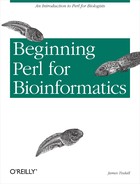One of the most exciting things about being involved in computer programming and biology is that both fields are rich in new techniques and results.
Of course, biology is an old science, but many of the most interesting directions in biological research are based on recent techniques and ideas. The modern science of genetics, which has earned a prominent place in modern biology, is just about 100 years old, dating from the widespread acknowledgement of Mendel's work. The elucidation of the structure of deoxyribonucleic acid (DNA) and the first protein structure are about 50 years old, and the polymerase chain reaction (PCR) technique of cloning DNA is almost 20 years old. The last decade saw the launching and completion of the Human Genome Project that revealed the totality of human genes and much more. Today, we're in a golden age of biological research—a point in human history of great medical, scientific, and philosophical importance.
Computer science is relatively new. Algorithms have been around since ancient times (Euclid), and the interest in computing machinery is also antique (Pascal's mechanical calculator, for instance, or Babbage's steam-driven inventions of the 19th century). But programming was really born about 50 years ago, at the same time as construction of the first large-scale, programmable, digital, electronic computers (such as ENIAC ). Programming has grown very rapidly to the present day. The Internet is about 20 years old, as are personal computers; the Web is about 10 years old. Today, our communications, transportation, agricultural, financial, government, business, artistic, and of course, scientific endeavors are closely tied to computers and their programming.
This rapid and recent growth gives the field of computer programming a certain excitement and requires that its professional practitioners keep on their toes. In a way, programming represents procedural knowledge—the knowledge of how to do things—and one way to look at the importance of computers in our society and our history is to see the enormous growth in procedural knowledge that the use of computers has occasioned. We're also seeing the concepts of computation and algorithm being adopted widely, for instance, in the arts and in the law, and of course in the sciences. The computer has become the ruling metaphor for explaining things in general. Certainly, it's tempting to think of a cell's molecular biology in terms of a special kind of computing machinery.
Similarly, the remarkable discoveries in biology have found an echo in computer science. There are evolutionary programs, neural networks, simulated annealing, and more. The exchange of ideas and metaphors between the fields of biology and computer science is, in itself, a spur to discovery (although the dangers of using an improper metaphor are also real).
It's necessary to review some of the very basic concepts and terminology of DNA and proteins at this point. This review is for the benefit of the nonbiologist; if you're a biologist you can skip the next two sections.
DNA is a polymer composed of four molecules, usually called bases or nucleotides. Their names and one-letter abbreviations are adenine (A), cytosine (C), guanine (G), and thymine (T).[1] (See Chapter 4 for more about how DNA is represented as computer data.) The bases are joined end to end to form a single strand of DNA.
In the cell, DNA usually appears in a double-stranded form, with two strands wrapped around each other in the famous double helix shape. The two strands of the double helix have matching bases, known as the base pairs. An A on one strand is always opposite a T on the other strand, and a G is always paired with a C.
There is also an orientation to the strands. One end of a nucleotide is called the 5' (five prime) end, and the other is called the 3' (three prime) end. When nucleotides join to make a single strand of DNA, they always connect the 5' end of one to the 3' end of the other. Furthermore, when the cell uses the DNA, as in transcribing it to RNA, it does so base by base from the 5' to the 3' direction. So, when DNA is written, it's usually written left to right on the page, corresponding to the 5' to 3' orientation of the bases. An encoded gene can appear on either strand, so it's important to look at both strands when searching or analyzing DNA.
When two strands are joined in a double helix (as in Figure 1-1), the two strands have opposite orientations. That is, the 5' to 3' orientation of one strand runs in an opposite direction as the 5' to 3' orientation of the other strand. So at each end of the double helix, one strand has a 3' end; the other has a 5' end.
Because the base pairs are always matched A-T and C-G and the orientation of the strands are the reverse of each other, the term reverse complement describes the relationship of the bases of the two strands. It's "reverse" because the orientations are reversed, and "complement" because the bases always pair to their complementary bases, A to T and C to G.
Given these facts and a single strand of DNA, it's easy to figure what the matching strand would be in the double helix. Simply change all bases to their complements: A to T, T to A, C to G, and G to C. Then, since DNA is written in the 5' to 3' direction, after complementing the DNA, write it in reverse.
GenBank, the Genetic Sequence Data Bank (http://www.ncbi.nlm.nih.gov), contains most known sequence data. We'll take a closer look at GenBank in Chapter 10.
[1] These names come from where they were originally found: the glands, the cell, guano, and the thymus.

